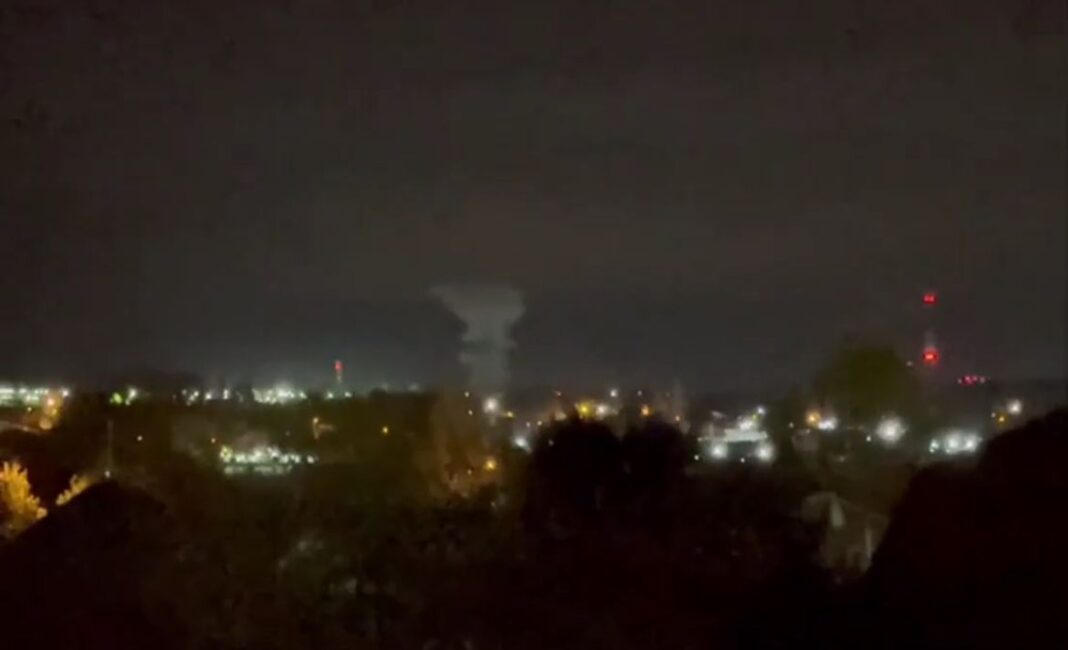On the night of 6–7 May, long-range drones operated by the Security Service of Ukraine (SSU) carried out powerful strikes deep inside Russian territory. These drone attacks were aimed at two of Russia’s most important defense plants.
Two Important Russian Defence Plants Hit by Ukrainian Drones
The first drone strike took place in the town of Krasnoarmeysk, located in the Moscow region. The target was the Bazalt defence plant. This factory is one of Russia’s biggest and most important arms production centers. It supplies weapons and ammunition to all parts of the Russian military.
Local residents in Krasnoarmeysk said they heard at least seven loud explosions. A fire started at the factory following the explosions. Thick smoke was seen billowing into the sky in certain postings and videos on Russian Telegram accounts. It caused concern among locals, although no civilian homes were directly hit.
The second drone strike happened in the city of Tula. Ukrainian drones targeted the Splav defence plant, another major facility in Russia’s military system. The Splav plant is the only place in Russia where multiple launch rocket systems (MLRS) and their ammunition are designed and built. These weapons are used by the Russian army during its military operations.
Ukraine’s Precision Strike Shatters Russia’s Elite $7M Drone Command Base in Kursk
Similar to the Krasnoarmeysk attack, the Tula strike resulted in a significant conflagration. The building was emitting a lot of smoke. The attack severely disrupted the operations at the defense plant.
Airport Closures After Drone Attacks
These Ukrainian drone operations did more than just damage military factories. In response to the drone activity, Russian authorities implemented something called the Kovyor (meaning “Carpet”) plan. This is a special emergency procedure used when drones or other flying threats are detected near important areas.
As part of this plan, airports across Moscow Oblast were forced to shut down for safety. Flights could not take off or land during the emergency. Numerous travelers were left stranded at airports as hundreds of flights were canceled. This shows how even a few Ukrainian drones can cause large-scale disruptions, not only to military targets but also to civilian services like air travel.
Russian officials did not make many public comments about the strikes. However, several Russian Telegram channels and news outlets shared updates about the explosions and fires at both sites. Ukrainian drones had caused significant damage, and emergency services were reportedly sent to put out the fires. The exact details about the damage were not made public.
Ukraine Says Only Military Targets Were Hit
A representative from Ukraine’s defense forces made a strong statement after the attacks. According to the source, these strikes are part of a larger effort by Ukraine to weaken Russia’s ability to carry out its military actions in Ukraine.
Ukraine’s Cross-Border Missile Strikes Breach Russian Defense Zones
The source explained that, unlike Russia, which often targets apartment buildings and civilian areas in Ukraine, the SSU carefully chooses its targets to focus only on military sites.
The official stated, “Unlike Russia, which targets residential buildings in peaceful cities, the SSU focuses exclusively on military sites that contribute to the enemy’s aggression against Ukraine. Our efforts to weaken Russia’s military strength will persist.”
This message suggests that Ukraine is using its Ukrainian drone program to hit key defence locations without causing harm to civilian areas. It also highlights the importance of Ukrainian drone technology in modern warfare. These drones can travel long distances and reach important sites deep inside enemy territory without putting pilots at risk.
Both the Bazalt and Splav plants play vital roles in the Russian defense system. Damaging these Ukrainian-targeted facilities can slow down weapon production and reduce the number of arms being used in the ongoing conflict.
Although no official numbers have been released about how much damage was done, the large fires and smoke clouds seen in videos suggest that the attacks were significant. The Ukrainian drone strikes sent a strong message about Ukraine’s ability to reach important Russian targets, even those far from the border.
These events mark one of the rare times when Ukrainian drones have successfully struck multiple high-value military sites inside Russia on the same night. The use of drones in this way is becoming an important part of the conflict, showing that war is no longer just about soldiers and tanks, but also about technology and strategy.
For now, the key facts remain: Ukraine used long-range drones to hit two critical Russian defense plants in Krasnoarmeysk and Tula. Both facilities are responsible for making weapons that support Russia’s war efforts. Fires broke out, airports were shut down, and Ukraine confirmed that the strikes were aimed only at military targets.
These actions have added another chapter to the complex and ongoing conflict between the two countries.

